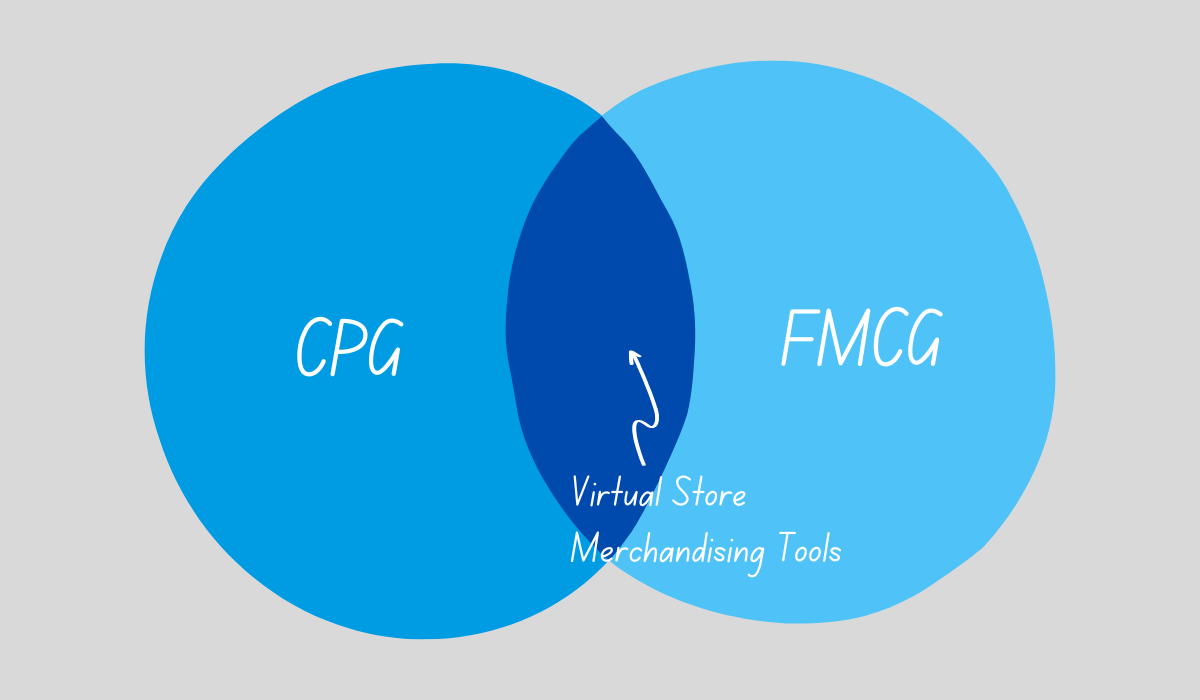Have you ever strolled through your favorite supermarkets or grocery stores and noticed how certain product categories seem to complement each other? This is no accident. Retailers have long recognized the value of cross-category merchandising. It’s the art of strategically placing products together to enhance the in-store experience.
In the competitive retail landscape, store owners must anticipate their customers’ shopping patterns. They can identify which product categories sell better when marketed together. This way, they can create a point of sale (POS) strategy that meets and exceeds customer expectations.
This blog will explore the benefits of creative cross-category merchandising and how virtual reality can help retailers take their merchandising efforts to new heights.
The impact of creative cross-category merchandising on sales and brand awareness
So, what exactly is creative cross-category merchandising? It’s an in-store marketing strategy that involves grouping products from different categories in one cohesive display. The goal is to encourage shoppers to buy additional items that were not on their shopping list while enhancing the customer experience.
This strategy also promotes brand recognition by showcasing products in unexpected ways. But the most significant benefit of cross-category merchandising is its potential to drive sales.
Think about seasonal merchandising like Halloween. Supermarkets often place costumes, candy, and decorations in the same aisle or area. This placement makes it easy for shoppers to find everything they need in one convenient location.
The key to successful cross-merchandising is to make a clear and logical connection between the products being displayed together. For instance, placing diapers next to sunscreen might not seem like an obvious pairing. But what about swim diapers? For parents with young children, this combination makes perfect sense. If parents are making a shopping run before a pool day to pick up swim diapers, they may see the sunscreen and decide to add it to their basket.
E-commerce giants like Amazon have also recognized the value of cross-merchandising. They do a good job offering product recommendations based on customer browsing and purchasing history. Retailers can replicate the convenience and customization of e-commerce by incorporating a cross-merchandising strategy into brick-and-mortar stores.
Introduce customers to new products and categories
One of the primary benefits of cross-category merchandising is to introduce customers to new products they may not have considered before. Strategically placing complementary items together can pique shoppers’ curiosity, encouraging them to explore unfamiliar products.
For example, a customer walks into a retail store looking for a new book to read. Suppose the retailer has thoughtfully placed a cozy display of soft blankets, reading lamps, and soothing candles near the book section. Maybe they’ve never used a reading lamp or haven’t tried that specific candle scent yet. In that case, the customer might be enticed to pick up a few extra items to enhance their reading experience.
This subtle nudge is what makes cross-category merchandising so effective. It creates a sense of convenience and added value for the shopper, leading to increased sales for the retailer.
Build brand awareness and increase brand recognition
Cross-category merchandising can also help retailers build brand awareness and increase brand recognition among their target audience. Creatively showcasing products in novel and unexpected ways can leave a lasting impression on customers.
For example, a health food store could display a selection of nutritious snacks alongside fitness equipment. This strategic placement reinforces the store’s commitment to promoting a healthy lifestyle. But it also helps the retailer stand out from competitors who may not be implementing this type of strategy. As a result, customers are more likely to remember and return to the store for future purchases.
Allows for creative and visually compelling displays
When it comes to cross-category merchandising, presentation is everything. Retailers can draw attention to their brand, drive foot traffic, and increase customer engagement by incorporating visually compelling product displays into their retail spaces.
It’s also about the experience that these displays create for shoppers. What kind of feelings are they trying to invoke when putting together a display? Showcasing products in an aesthetically pleasing manner helps capture shoppers’ attention by tapping into nostalgia, curiosity, etc. Once they are hooked on that display, the subsequent sales come easy.
For example, a display showcasing kitchen gadgets and accessories shouldn’t stop there. They might create a display showcasing colorful tools and utensils alongside vibrant dishware. This visually appealing presentation can entice customers to stop and explore the products further because they like the way it looks. If retailers can get them to think, “I want my kitchen to look like that,” the likelihood of them making a purchase increases.
Creative examples of cross-category merchandising
We’ve all had the experience of walking into a store and buying something we didn’t plan on purchasing. That’s the magic of displaying complementary products from different categories.
This strategy could involve a simple tweak in secondary product placement, signage, or end cap displays of related products in a way that catches the customer’s eye. So, what are some cross-merchandising ideas that have taken different stores by storm? Here are some examples:
Target’s collaboration with Lilly Pulitzer
Picture this: you walk into Target, and there it is. A limited-edition collection of vibrant apparel, accessories, and home décor blending the aesthetics of Target and Lilly Pulitzer. With 15 colorful patterns, the collection appeals to a wide range of customers.
This collaboration had shimmering accessories and glam barware like swizzle sticks in silver and gold. There were tinted glass champagne coupes and stylish Collins glasses. Additionally, they curated cosmetics with exclusive L’Oreal lipsticks and Essie nail polishes.
But why was this partnership so successful? It’s quite simple. They leveraged the combined strengths of two well-known brands, Target and Lilly Pulitzer, in a new and creative way. The result was a unique shopping experience that appealed to both core audiences. Have you ever strolled through your favorite supermarkets or grocery stores and noticed how certain product categories seem to complement each other? This is no accident. Retailers have long recognized the value of cross-category merchandising. It’s the art of strategically placing products together to enhance the in-store experience.
In the competitive retail landscape, store owners must anticipate their customers’ shopping patterns. They can identify which product categories sell better when marketed together. This way, they can create a point of sale (POS) strategy that meets and exceeds customer expectations.
This blog will explore the benefits of creative cross-category merchandising and how virtual reality can help retailers take their merchandising efforts to new heights.
The impact of creative cross-category merchandising on sales and brand awareness
So, what exactly is creative cross-category merchandising? It’s an in-store marketing strategy that involves grouping products from different categories in one cohesive display. The goal is to encourage shoppers to buy additional items that were not on their shopping list while enhancing the customer experience.
This strategy also promotes brand recognitio
Sephora’s fragrance merchandising
Sephora is another example of a successful cross-category merchandising strategy. Sephora’s innovative approach involves fragrances with cross-merchandised products, such as makeup and skincare.
This strategy works well because it taps into the buyer’s psychology. When a customer smells a fragrance they like, they are more likely to be interested in other products that share a similar scent profile or color palette. Cross-merchandising fragrances with makeup and skincare helped Sephora increase sales of their fragrances and encouraged customers to explore and purchase related items.
Whole Foods’ “Cheese & Beer” pairing promotion
What’s better than a delicious slice of cheese? A perfectly paired beer to go with it! Whole Foods recognized this winning combination. They created a promotion that showcased the complementary flavors of different cheeses and beers. Foodie and Cheese Expert Janet Fletcher was even on-site to explain the pairing.
This strategy worked well for several reasons. First, it encouraged customers to try new products they might not have thought of pairing together. Second, it created a sense of community and excitement around the author’s events, increasing foot traffic and sales. Finally, showcasing its expertise in curating these pairings, Whole Foods reinforced its brand as a trusted source for artisanal products.
Ikea showrooms
Ikea showrooms are like a playground for adults. An endless maze of beautifully designed rooms filled with furniture, accessories, and décor items. The way Ikea displays its products makes it easy for customers to picture how these items would look in their own homes. As they walk through the displays, customers can compare different setups and pick up products as they go, ultimately making buying decisions based on their unique customer needs.
The success of Ikea‘s showroom lies in its ability to appeal to the customer’s imagination. By cohesively displaying products from different categories, Ikea encourages customers to envision the possibilities for their own spaces. Some people are even known to come simply for the experience and end up making a purchase.
Cross-category merchandising with virtual reality technology
If you’re looking for a fresh approach to cross-category merchandising that utilizes the latest technology, look no further than virtual reality (VR) merchandising with 3D simulation software. VR tools can help retailers like you create eye-catching displays that keep customers coming back for more. So, how does this work?
Imagine walking into a store where every shelf, display, and mannequin has been curated to perfection. Products from different categories are paired together in a way that encourages shoppers to buy more while maximizing their time in the store. It sounds like a dream come true, right? With InContext Solutions’ technology, retailers can handcraft immersive environments that are essentially digital clones of a store. Here are some of the things retailers can do with virtual reality for visual merchandising:
Create immersive, interactive environments
As a retailer, you understand the challenge of setting up a fresh and enticing display only to find that it doesn’t generate the results you were hoping for. With VR merchandising software, you can experiment with different combinations in a risk-free environment. It allows you to virtually explore the entire store before committing to any shelf arrangement or store layout.
Think of it as painting on a blank canvas: you have complete control over the look and feel of your store. You can mix and match items from various categories or create dynamic displays in VR. You can even simulate shopper interactions to ensure the optimal placement of products.
Quickly and easily test out different merchandising strategies
One of the advantages of using VR for cross-category merchandising is the ability to easily test out different strategies. No more wasting time and money on trial-and-error displays. With 3D software, you can quickly visualize how different techniques will look in a realistic digital twin of the space.
Need to place a life-sized mannequin in the middle of the store? No problem. Want to rearrange shelves and change the lighting? It’s as easy as a few clicks. With VR, you can fine-tune until you achieve the perfect balance between aesthetics and functionality.
Gather data on customer engagement and behavior
Another critical aspect of cross-merchandising is understanding how customers interact with your store. Using virtual reality to test out your display strategy and gather shopper behavior data. Metrics like basket size, shopper time, and customer satisfaction help retailers make more informed decisions about merchandising strategies.
Identify trends and preferences that will help you tailor your efforts for maximum impact. For example, if you notice that shoppers tend to linger longer in a particular aisle, you might consider setting up a display of complementary items nearby.
Create personalized shopping experiences
In today’s competitive retail industry, customer loyalty is more important than ever. That’s why creating personalized shopping experiences is crucial for keeping shoppers engaged. Virtual reality retail merchandising allows shoppers to explore different products and categories in a way that feels tailored to individual interests.
For example, retailers could create a cross-category experience for parents because their VR testing shows that certain products do well with that demographic. This experience could involve creating a back-to-school display where kids’ snacks are placed next to lunchboxes, backpacks, and school supplies.
Curating unique shopping experiences that cater to each customer’s tastes will foster a sense of loyalty and trust that can boost sales and long-term success. This merchandising opportunity is one that you don’t want to miss.
Unlock your creative potential for cross-category merchandising with InContext Solutions
There are so many possibilities that VR retail can offer for your cross-category merchandising strategy. But how do you get started? The answer is simple: InContext Solutions. Our technology empowers you to implement robust merchandising techniques to reach the full potential of cross-merchandising displays.
As the retail industry continues to evolve, staying ahead of the curve is essential for success. With InContext, you’ll be well-equipped for more than keeping up with the competition. You’ll also thrive in an ever-changing market.
Get in touch with InContext today to discover how we can help you revolutionize cross-merchandising.





